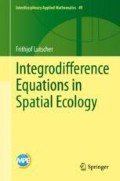Abstract
We derive the basic integrodifference equation and discuss its two main ingredients: the growth function and the dispersal kernel. We introduce several ecological concepts that recur throughout this book and highlight how ecological assumptions are reflected in the mathematical model. This detailed understanding will allow us to formulate ecological insights from the mathematical results and understand the limitations of these insights.
Access this chapter
Tax calculation will be finalised at checkout
Purchases are for personal use only
References
Allee, W. (1949). Principles of animal ecology. Christchurch: Saunders.
Andersen, M. (1991). Properties of some density-dependent integrodifference equation population models. Mathematical Biosciences, 104, 135–157.
Bellows, T. (1981). The descriptive properties of some models for density dependence. Journal of Animal Ecology, 50(1), 139–156.
Beverton, R., & Holt, S. (1957). On the Dynamics of Exploited Fish Populations. Fisheries Investigation Series (vol. 2, no. 19). London: Ministry of Agriculture, Fisheries, and Food.
Brännström, A., & Sumpter, D. (2005). The role of competition and clustering in population dynamics. Proceedings of the Royal Society of London B, 272, 2065–2072.
Bullock, J., & Clarke, R. (2000). Long distance seed dispersal by wind: Measuring and modelling the tail of the curve. Oecologia, 124, 506–521.
Courchamp, F., Berec, L., & Gascoinge, J. (2008). Allee effects. Oxford: Oxford University Press.
Edelstein-Keshet, L. (2005). Mathematical models in biology. Philadelphia: SIAM.
Etienne, R., Wertheim, B., Hemerik, L., Schneider, P., & Powell, J. (2002). The interaction between dispersal, the Allee effect and scramble competition affects population dynamics. Ecological Modelling, 148, 153–168.
Fujiwara, M., Anderson, K., Neubert, M., & Caswell, H. (2006). On the estimation of dispersal kernels from individual mark-recapture data. Environmental and Ecological Statistics, 13, 183–197.
Geritz, S., & Kisdi, É. (2004). On the mechanistic underpinning of discrete-time population models with complex dynamics. Journal of Theoretical Biology, 228, 261–269.
Hassell, M. (1975). Density-dependence in single-species populations. Journal of Animal Ecology, 44(1), 283–295.
Kot, M. (2001). Elements of mathematical ecology. Cambridge: Cambridge University Press.
Kot, M., Lewis, M., & van den Driessche, P. (1996). Dispersal data and the spread of invading organisms. Ecology, 77, 2027–2042.
Lewis, M., Neubert, M., Caswell, H., Clark, J., & Shea, K. (2006). A guide to calculating discrete-time invasion rates from data. In M. Cadotte, S. McMahon, & T. Fukami (Eds.), Conceptual ecology and invasions biology: Reciprocal approaches to nature (pp. 169–192). Berlin: Springer.
Lutscher, F., & Petrovskii, S. (2008). The importance of census times in discrete-time growth-dispersal models. Journal of Biological Dynamics, 2(1), 55–63.
May, R. (1975). Biological populations obeying difference equations: Stable points, stable cycles, and chaos. Journal of Theoretical Biology, 51, 511–524.
Murray, J. D. (2001). Mathematical biology I: An introduction. Berlin: Springer.
Musgrave, J., Girard, A., & Lutscher, F. (2015). Population spread in patchy landscapes under a strong Allee effect. Theoretical Ecology, 8(3), 313–326.
Nathan, R., Klein, E., Robledo-Arnuncio, J. J., & Revilla, E. (2012). Dispersal kernels: Review. In J. Clobert, M. Baguette, T. G. Benton, & J. M. Bullock (Eds.), Dispersal ecology and evolution (chap. 15.1). Oxford: Oxford University Press.
Neubert, M., Kot, M., & Lewis, M. A. (1995). Dispersal and pattern formation in a discrete-time predator–prey model. Theoretical Population Biology, 48(1), 7–43.
Ricker, W. (1954). Stock and recruitment. Journal of Fisheries Research Board of Canada, 11, 559–632.
Sandefur, J. (2018). A unifying approach to discrete single-species populations models. Discrete & Continuous Dynamical Systems - Series B, 23, 493–508.
Schreiber, S. (2003). Allee effects, extinctions, and chaotic transients in simple population models. Theoretical Population Biology, 64, 201–209.
Tufto, J., Ringsby, T.-H., Dhondt, A., Adriaensen, F., & Matthysen, E. (2005). A parametric model for estimation of dispersal patterns applied to five passerine spatially structured populations. The American Naturalist, 165, E13–E26.
Veit, R. R., & Lewis, M. A. (1996). Dispersal, population growth, and the Allee effect: Dynamics of the house finch invasion in eastern North America. The American Naturalist, 148(2), 255–274.
Wang, M.-H., Kot, M., & Neubert, M. (2002). Integrodifference equations, Allee effects, and invasions. Journal of Mathematical Biology, 44, 150–168.
Author information
Authors and Affiliations
Rights and permissions
Copyright information
© 2019 Springer Nature Switzerland AG
About this chapter
Cite this chapter
Lutscher, F. (2019). Modeling with Integrodifference Equations. In: Integrodifference Equations in Spatial Ecology. Interdisciplinary Applied Mathematics, vol 49. Springer, Cham. https://doi.org/10.1007/978-3-030-29294-2_2
Download citation
DOI: https://doi.org/10.1007/978-3-030-29294-2_2
Published:
Publisher Name: Springer, Cham
Print ISBN: 978-3-030-29293-5
Online ISBN: 978-3-030-29294-2
eBook Packages: Mathematics and StatisticsMathematics and Statistics (R0)

